Your new employees need time—as long as 12 months in some cases—to learn the ropes of the organization and reach their full performance potential within a role. However, it’s crucial to set them up for success and give them clear goals to work toward.
This is where creating a 30-60-90 day plan is important. This is a structured onboarding plan for new hires, where goals and activities are spaced across 30-day, 60-day, and 90-day periods.
In this article, we’ll show you how to create this plan and contextually onboard new employees at every step of their onboarding journey.
- What is a 30-60-90 Day Plan?
- Important Elements of a 30-60-90 Day Plan
- How to Write a 30-60-90-Day Plan in Five Easy Steps
- Step 1: Write down the company mission
- Step 2: Brainstorm on the first 30 days’ objectives
- Step 3: Create goals for the first 60 days and 90 days respectively
- Step 4: Highlight the right resources
- Step 5: Keep an eye on the progress being made
- Improving time management with 30-60-90 day plans
- Dealing with employee retention using 30-60-90 day plans
- Using the 30-60-90 day plan for smart recruitment and job interviews
- The Benefits of a 30-60-90 Day Plan
- What a 30-60-90 Day Plan Looks Like for Different Roles
- How to make a 30-60-90 day plan for managers
- How to make a 30-60-90 day plan for product managers
- How to make a 30-60-90 day plan for executives
- How to make a 30-60-90 day plan for sales managers
- How to make a 30-60-90 day plan for data analysts
- How to make a 30-60-90 day plan for IT managers
- How to make a 30-60-90 day plan for new employees
- Give New Employees the Best Start Possible with ClickUp
- Frequently Asked Questions
What is a 30-60-90 Day Plan?
A 30-60-90 day plan is exactly what it sounds like—it is a document that outlines critical milestones, actionable goals, and high-level priorities for new employees to achieve in the first 30, 60, and 90 days of their employment. The hiring manager of the new employee is responsible for creating one.
What the 30-60-90 day plan does:
- Highlights workable goals to hit in the first three months of a new hire’s employment, breaking them down into 30-, 60-, and 90-day increments.
- Simplifies what the employee should be focusing on
- Demonstrates metrics to measure success at the 30-, 60-, and 90-day marks
- Helps new employees to maximize their output and accomplish set milestones aligned with the company’s mission
Important Elements of a 30-60-90 Day Plan
The central concept of a good 30-60-90 day plan revolves around:
- Converting larger goals into smaller, more digestible milestones
- Setting up an ultimate goal for 90 days with steps to be accomplished at the 30- and 60-day marks
- Ensuring goals are achievable yet challenging
- Getting buy-in from new employees by making them chart out or contribute to the plan
- Aligning the plan with the company’s mission to help new hires understand their role in the organization and move along easily
The five parts of a good 30-60-90 day plan
Before we learn how to create a 30-60-90 day plan, let’s first see what it involves.
What makes a 30-60-90 day plan great? For starters, it must immediately clarify the organization’s expectations from the new hire.
A great 30-60-90 day plan has five high-level elements:
- Goals: States the company’s purpose, mission, and clear objectives in a concrete and measurable manner; categorizes the new hire’s goals into learning goals, professional goals, performance goals, and personal goals for best results
- Focus: Specifies what the new hire needs to focus on during each phase to stay on track and work towards strategic goals
- Priorities: Identifies vital tasks and projects that the new hire needs to prioritize in each 30-day period to manage their time and progress effectively
- Metrics of success: Defines the key performance indicators (KPIs) to measure the new hire’s success, offers clarity on what success looks like, and helps them track progress
- Flexibility: It should be flexible enough to adapt to changing circumstances, allowing new hires to adjust their goals and priorities as per the overall objectives of the company
Integrate SMART goals within your 30-60-90 day plan
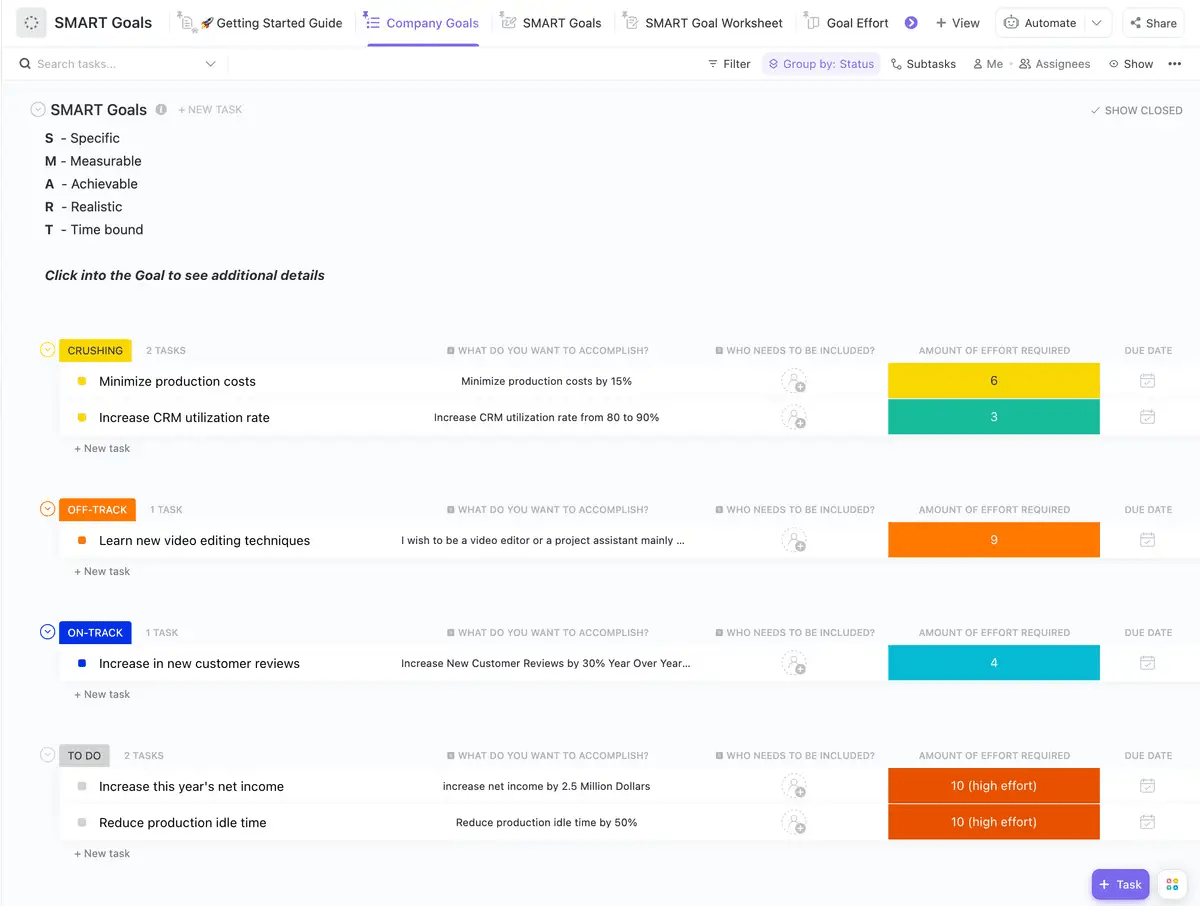
To make your 30-60-90 day plan workable, try writing SMART goals. Your 30-60-90 day plan should have specific objectives that are measurable, achievable, realistic, and time-bound:
- Specific: Clearly define what you want to achieve in each 30, 60, and 90-day period. For example, instead of setting a vague goal like ‘improve project efficiency,’ set a specific goal such as ‘reduce project timelines by 10%’
- Measurable: Include key performance indicators to track your progress, such as project completion time, cost savings, customer satisfaction scores, etc.
- Achievable: Set challenging and realistic goals. For example, aiming to reduce project timelines by 50% in 30 days may not be achievable, but a 10% reduction could be realistic
- Relevant: Ensure that your goals align with the overall objectives of the company and the project
- Time-bound: Set specific deadlines for achieving each goal to stay focused and track progress over time
How to Write a 30-60-90-Day Plan in Five Easy Steps
Creating a 30-60-90 day plan is easy as long as you follow these five steps:
Step 1: Write down the company mission
The company mission is the foundational bone of your 30-60-90 day plan. So, identify the company goals and milestones so the new employee understands their role in the larger scheme.
Step 2: Brainstorm on the first 30 days’ objectives
Write what you want the person to achieve in the first 30 days. As a thumb rule:
- Restrict the number of goals to three to five
- Write down a key metric for every goal mapped to measure it accurately
Step 3: Create goals for the first 60 days and 90 days respectively

Map goals for the first 60 and 90 days, as you created goals for the first 30 days. Keep in mind the same rules as mentioned in the previous step.
Step 4: Highlight the right resources
Your 30-60-90 day plan is only as valuable as the supplementary resources you provide, such as:
- Key contacts, i.e., team members and stakeholders for specific aspects of the plan (Who the new hire should connect with for achieving the goals or for questions they may have)
- Training materials (List of tutorials, webinar links, documents, and other resources that will help the new hire acquire the knowledge and skills necessary to succeed in their role)
- Internal tools and systems (Instructions for accessing existing tools the organization uses)
- External resources (Industry publications, online forums, professional organizations, etc. to get valuable insights and support)
Step 5: Keep an eye on the progress being made
The final leg is about evaluating the progress of the plan:
- Is the new hire achieving their goals?
- Are they using the resources you outlined?
- Are they facing challenges head-on?
- Are they on the same page about the company objectives?
If all this seems like too much work, use ClickUp’s 30-60-90 Day Template to get started on your onboarding with one click:
This template ensures your new hires:
- Are well-adjusted in the first three months with perfectly mapped personal objectives and business goals
- Take action on required onboarding tasks with regularly reviewed behaviors, skills, and competencies
- Get up-to-speed quickly
- Document progress and track action items from day one
We’ve looked at how to create a 30-60-90 day plan. Let’s now understand how a hiring manager can use 30-60-90 day plans to improve their time management, employee retention, and recruitment processes.
Improving time management with 30-60-90 day plans
Every 30-60-90 day plan looks different for different individuals. However, there are a few techniques you can leverage to gain time management benefits:

- Prioritize: Factor in what you want your new employee to prioritize. Use colored flags in key tasks to let them know the relative importance of each
- Self-reflection: Include reflection time within the plan
- Strategic development: Categorize goals into three parts—first month, second month, and third month, with the goals increasing in difficulty
- Learning: Add in time for driving professional development and promoting ongoing learning
Stay on top of your monthly tasks and manage time like a pro with ClickUp Calendar View, which can be synced with your Google Calendar:

Dealing with employee retention using 30-60-90 day plans
The 30-60-90 day plan enables you to create a lasting positive impression in the employee’s mind:

- Employee voice: Once you hit the 30-day mark, survey the new hire to ask about their onboarding process experience. This way, they’ll feel their voice matters to the organization, boosting the engagement rate
- On-demand content: Roll out on-demand content that highlights the company’s culture, values, and mission and encourages meaningful relationships with employees
- Clarity: Emphasizing the role of employees in their new organization for the first 90 days lays the foundation for a happier work experience. Collaborate with the employee and build an instructions-driven, crystal-clear plan of action
Related: Transition plan templates to simplify your job
Using the 30-60-90 day plan for smart recruitment and job interviews
From a hiring manager’s perspective, a 30-60-90 day plan can enhance the hiring and interview process significantly. Here’s how:
- Assess goal alignment: Managers can use the plan to gauge the candidate’s understanding of the role and how they plan to align their goals with the organization’s objectives in the first 30, 60, and 90 days
- Understand the candidate’s adaptability: Hiring managers can pick the candidate’s brains on how they plan to pivot their approach based on the specific responsibilities of the role
- Learn about the candidate’s resourcefulness: Managers can also use the plan to discuss how candidates would leverage available resources (think: training, tools, and team support) to achieve their goals effectively
- Evaluate the candidate’s problem-solving skills: Managers can present hypothetical scenarios and challenges and ask candidates how they would adjust their approach to overcome obstacles within the first 90 days
Related: Essential onboarding documents for new hires 📂
The Benefits of a 30-60-90 Day Plan
A 30-60-90 day plan is a blueprint of success—in that it identifies key milestones for new employees during their early employment days.
It draws parallels to a productivity plan—one that helps new team members:
- Know what’s expected of them
- Manage their workload
- Focus on goal-oriented tasks
- Set the right parameters for success
Here are the top benefits of a 30-60-90 day plan:
Productivity boost
A strategic onboarding plan is instrumental in boosting productivity; 61% of new hires feel prepared to take on a new role once they have undergone a structured onboarding.
The onboarding plan provides direction into how the new hire can get started quickly and offers one-click access to the right resources. The team understands what to prioritize and how to get help if they get stuck at any point in their onboarding journey:

To help the new hire understand their role and get contextual help, use a 30-60-90 day plan template.
Better team cohesion
A seamless onboarding experience is possible with the involvement of the team.
The team should meet and get to know each other early to build a strong foundation. Integrate one-on-one calls within your onboarding process and help team members get to know their colleagues and stakeholders.
Remember, the idea is to start building important relationships early and create a sense of teamwork. Along the way, managers must also clarify goals and elaborate on how the organization’s goals fit into team and individual goals.
To give the employee’s a solid understanding of team activities and deliverables, use ClickUp Kanban Board view to show all team tasks and their progress at one glance:

Consistent performance appraisals
Around 61% of employees would prefer staying at their current organization for development and career growth:
But you can’t develop what you don’t assess, right? This is where a 30-60-90 day plan adds performance reviews into a manager’s calendar and ensures that new hires are reviewed periodically.
Consistent reviews allow for better assessments of new hires’ progress and performance. This, in turn, helps them improve their skills, perform optimally, and integrate well into the organization.
The data says it all— ‘The half of workers who get meaningful performance enablement—have far higher levels of optimism, confidence, engagement, and productivity than the half of employees who don’t.’
Managers can have structured performance review discussions with the new hire with the help of the ClickUp 1:1 Meeting Template.
This Docs template helps managers input and track relevant information for new hires. It includes pre-built pages for employee roles, expectations, and recurring meeting agendas. For even more organization, create nested pages within each page.
Setting employees up to succeed

A 30-60-90 day plan details the initial three months of a new team member’s employment, introducing them to company policies, teamwork, and business objectives. It’s a surefire way to help your new hires get up to speed as they check off essential items at the 30-60-90 day milestones on their plan.
Get the newcomer off to a good start by ensuring they can access all the necessary documentation: company policies, team plans, organization chart, etc. Managers and HR teams can do this with shareable ClickUp Docs.
To make the 30-60-90 day plan useful, convert your plan into tasks for each 30-day period.
Use ClickUp Tasks to set up tasks and subtasks with their respective due dates:
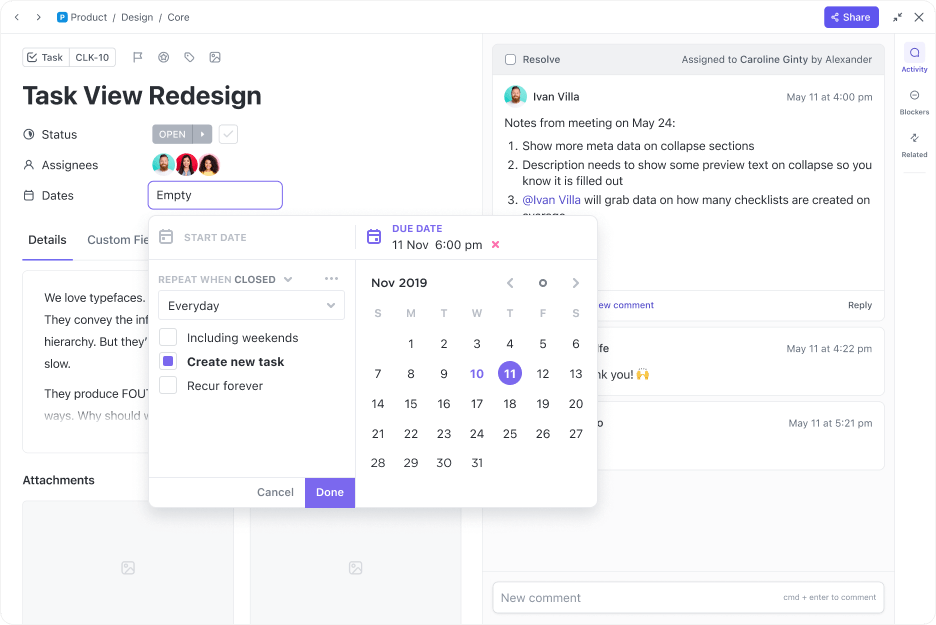
Once the deadlines are set, spoil the team with choices—let them view the tasks in multiple formats and filter tasks by priority as well as status:
You can also assign comments and link tasks with docs to ensure everyone is in the know at all times:

Finally, build full-fledged dashboards with your team goals and team effort metrics in place and visualize task progress easily:

What a 30-60-90 Day Plan Looks Like for Different Roles
A 30-60-90 day plan is many-sided, depending on who uses it and for what purpose.
But before we jump into that, let’s understand when to make a 30-60-90 day plan:
- New employees: Hiring managers should create a plan when onboarding a new employee to ease the transition period
- Existing employees: Team managers who want to roll out new initiatives or role changes must use a 30-60-90 day plan for offering existing employees a workable path
- Prospective employees: Potential candidates can use a 30-60-90 day plan to prepare for an interview and demonstrate seriousness to the hiring manager
How to make a 30-60-90 day plan for managers
Using an operational plan template is a no-brainer for managers who want to bring their ideas to life from the start.
To elevate their management skills, managers must add discipline to their work style by creating a 30-60-90 day plan, which can look something like this:
30-days
Goal: To improve the team’s time management skills using an improved implementation process:
- Conduct one-on-one meetings with team members to understand their roles (and challenges)
- Identify and implement one process improvement opportunity, such as better time management
- Set short-term goals with team members aligned with overall objectives
- Establish regular communication cadence with the team to track progress
60-days
Goal: To assess how the team is progressing with their time management skills

- Continue with one-on-one meetings to help the team assess their performance
- Use time-tracking tools to gather real-time data on team performance
- Assess the results of the team’s improvements relating to how well they’re managing their time
- Evaluate the results of the short-term goals identified in the first 30 days
- Refine the communication plan based on the team’s inputs and direct reports
- Set medium-term goals that build on the achievements of the first 30 days
90-days
Goal: To establish a culture of optimized time management for future projects while maintaining quality:
- Conduct a SWOT analysis and provide overall feedback to the team
- Conduct time management training sessions to address the skill gaps within the team
- Reassess the need to conduct meetings based on the team’s progress on a need basis
- Use the insights to create a long-term strategic plan which can be replicated for the future
How to make a 30-60-90 day plan for product managers
Product managers can leverage free project management software to accelerate their work without compromising on productivity or quality.
Having a structured 30-60-90 day plan is instrumental in helping new product managers quickly grasp their responsibilities and make a positive impact. Here’s a sample plan for your ready reference:
30-days
To identify three key customer pain points and propose solutions in the next product iteration:
- Conduct interviews with current customers to gather feedback on existing product
- Meet with the engineering team to understand the technical aspects of the product
- Analyze market trends and competitive products to identify areas for improvement
- Develop a plan to address any immediate customer concerns or product issues
- Build out a product requirement document

60-days
To have a validated prototype ready for implementation:
- Collaborate with the design team to create wireframes for the proposed product improvements
- Conduct user testing with the prototypes to validate the proposed solutions
- Work with the marketing team to develop a messaging strategy for the product improvements
90-days
To successfully launch the updated product iteration and measure a 15% increase in customer satisfaction based on post-launch feedback:
- Implement the product improvements in collaboration with the engineering team
- Launch the updated product and monitor performance metrics to ensure the desired impact
- Gather feedback from customers and internal stakeholders on product improvements
- Begin planning for the next product iteration based on the feedback and learnings from the current iteration
How to make a 30-60-90 day plan for executives
Executives and senior management can also benefit from the 30-60-90 day plan.
Here’s a sample plan you can take inspiration from to improve operational efficiency by 20% and increase team alignment with company goals:
30-days
- Conduct stakeholder interviews to understand current challenges and opportunities
- Identify quick wins to demonstrate leadership impact
- Implement a communication strategy to align teams with strategic goals
- Utilize work plan templates to map out high-level goals and action items for the first 90 days
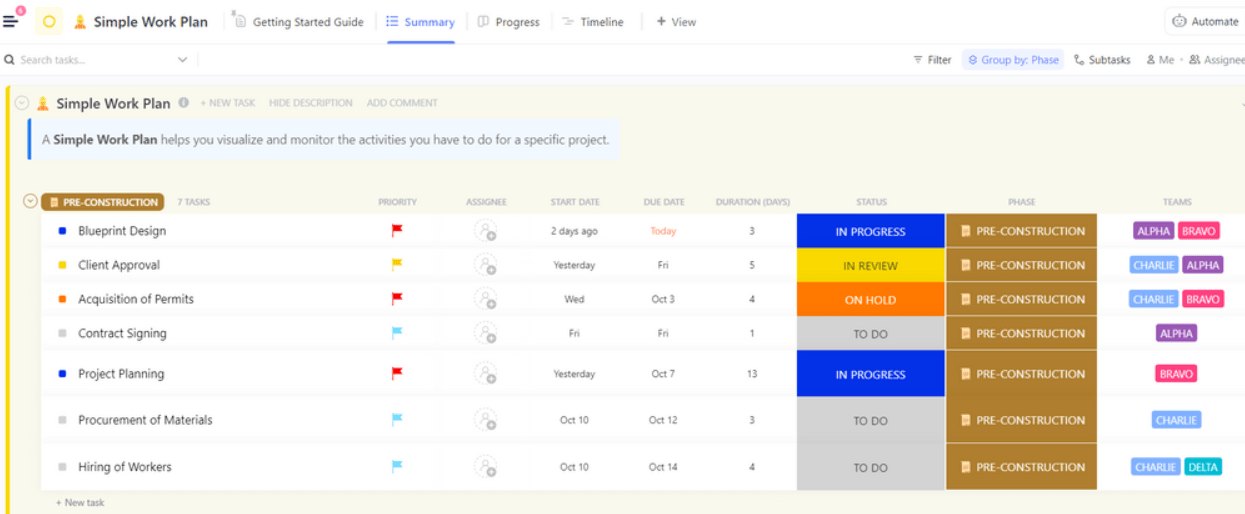
60-days
- Set up and lead a cross-functional team to address a key operational challenge
- Develop and implement a process improvement initiative
- Conduct a team skills assessment and begin targeted training programs
- Update the work plan template with measurable progress and adjust goals for the next 30 days
90-days
- Present a strategic plan for the next fiscal year based on insights from the first 60 days
- Launch a new product initiative
- Establish key performance indicators (KPIs) and metrics for team success
- Create a work plan for the next quarter, including detailed tasks and deadlines
How to make a 30-60-90 day plan for sales managers
Sales managers are already familiar with using goal-tracking apps to achieve their monthly or quarterly goals. A 30-60-90 day plan drives better performance.
Here’s an example worth looking into:
30-days
A new sales manager joins the team. Their goal for the first 30 days should all relate to the learning phase, aka completing training modules, shadowing sales calls, and conducting one-on-one meetings with team members.
In the first 30 days, they focus on:
- Learning about the existing products and sales processes
- Meeting cross-functional stakeholders
- Understanding the team dynamics
- Building relationships with team members
- Getting familiar with target customer personas and ideal customer profiles
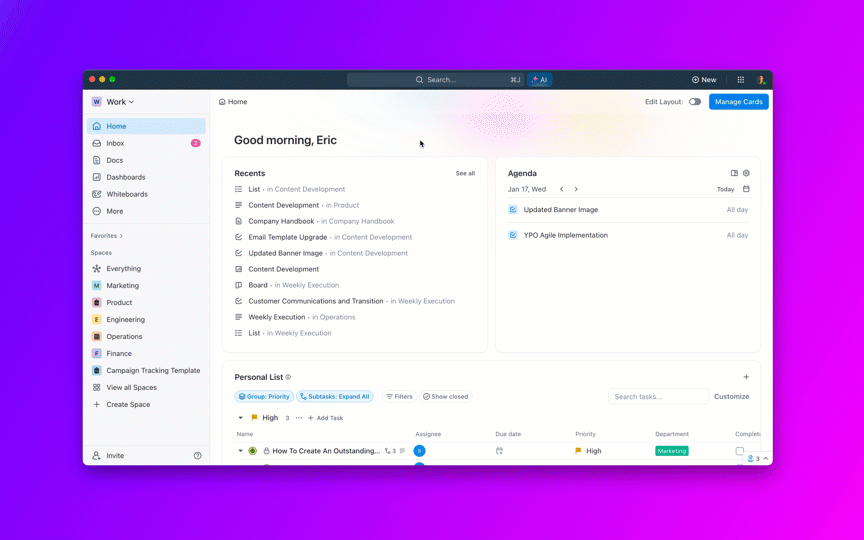
60-days
By day 60, the sales manager should have:
- Identified areas for performance improvement in the sales process
- Implemented changes, such as introducing new sales tools and refining the sales pitch
- Set concrete S.M.A.R.T goals for the next 30 days, such as growing the sales pipeline by 20% and improving sales team morale by assessing their time management metrics within the first quarter
90-days
At the 90-day mark, the sales manager should have:
- Successfully implemented a plan for a 15% increase in sales revenue
- Developed a long-term sales strategy based on their findings and insights from the first 90 days
- Leveraged the 30-60-90 day plan format to track progress and drive ongoing improvement
How to make a 30-60-90 day plan for data analysts
Data analysts can use a 30-, 60-, or 90-day plan to understand and improve the data analysis methodology at their organization.
Here’s an example for your convenience:
30-days
- Complete training on the firm’s data analysis tools and techniques and task management software
- Attend team meetings to understand current projects and contribute ideas
- Review data analysis best practices and apply them to work
- Complete training and contribute to a data project within the first 30 days
60-days
- Lead a small data analysis project
- Improve data analysis efficiency by 10%
- Collaborate with team members to streamline organizational processes
- Complete the project and present findings to the team by day 60

90-days
- Implement a new data visualization strategy
- Increase data visualization effectiveness by 20%
- Collaborate with the IT team to integrate tools for seamless analysis
- Continue to refine skills and stay updated with new tools
- Implement the strategy and gather feedback from the team by day 90
How to make a 30-60-90 day plan for IT managers
Newly hired IT managers must also have a 30-60-90 day plan ready to get an edge in a new business environment.
Here’s an example to help you create one:
30-days
- Get familiar with the company’s IT infrastructure and project planning tools
- Engage with the team to get to know them and their work style
- Review IT best practices and policies
60-days
- Use strategic thinking to plan and implement improvements to the IT infrastructure
- Work with team members to reduce downtime by 10%
- Complete the improvements and review progress by day 60
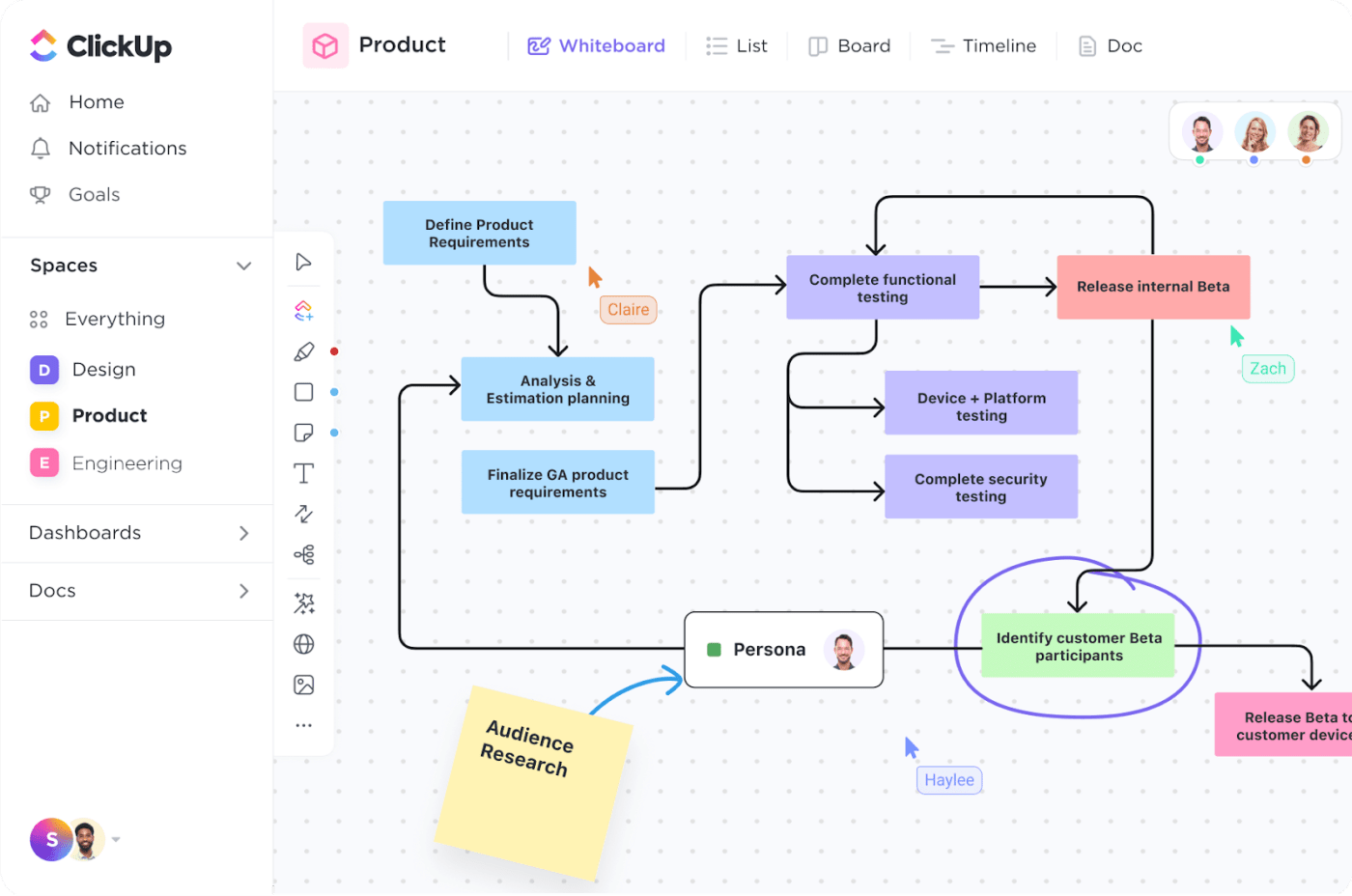
90-days
- Develop a long-term IT strategy
- Increase overall efficiency by 15%
- Collaborate with other departments to align IT goals with company objectives
- Implement the strategy and gather feedback from stakeholders by day 90
How to make a 30-60-90 day plan for new employees
You could pen the best job description in the world, but new employees will still feel overwhelmed without an onboarding plan.
This is where a strategic 30-60-90 day plan can help new employees get going from day zero.
Here’s an example of a 30-60-90 day plan for new employees worth emulating:
30-days
- Complete onboarding training and acclimate to the new job
- Demonstrate an understanding of key responsibilities and company culture
- Engage in ice-breaker sessions with team members to build relationships
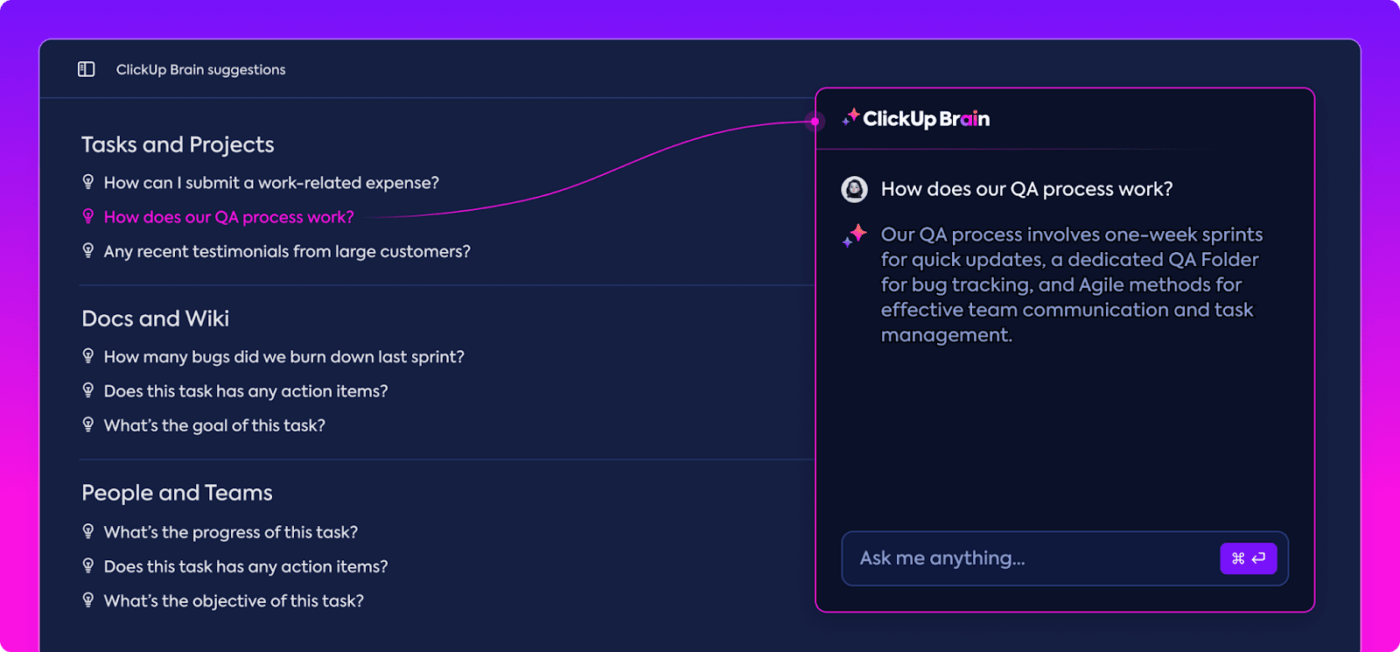
60-days
- Start contributing to team projects
- Receive and document feedback from mentor/team members
- Continue to learn and ask questions
- Attend training sessions to improve skills
- Complete assigned tasks and projects by day 60
90-days
- Take on more responsibilities and contribute ideas
- Complete projects and meet deadlines
- Seek feedback from supervisors and continue to grow in their new job
Give New Employees the Best Start Possible with ClickUp
The 30-60-90-day plan is an asset within any employer’s toolkit. It allows hiring leaders to onboard new hires easily, drive periodic performance reviews, and (literally) show the potential candidates what’s expected of them in the first 90 days of employment (and beyond).
However, creating the plan right is as vital as ensuring new employees hit the ground running as soon as possible.
Use ClickUp to enable new employees to embrace change, work smart beyond the 90-day mark, and reflect on how they’re faring with a mindful, well-conceived 30-60-90 day plan. Sign up now for free!
Frequently Asked Questions
1. What should a 30-60-90 day plan include?
A 30-60-90 day plan should include the company’s current goals and how the employee will achieve the milestones at the 30-, 60-, and 90-day marks. It should also include relevant resources, activities, and training that the new employee might need to get to the finish line.
2. How do I create a 30-60-90 day training plan?
Follow these steps to create a 30-60-90 day training plan:
- Step 1: Write down the company mission, focusing on short and long-term priorities
- Step 2: Write the goals you want to achieve in the first 30, 60, and 90 days, along with key metrics for every goal
- Step 3: Add all the relevant resources the new hire will need to achieve the end goal quickly, including training material, contact information for important people, etc.
- Step 4: Track progress with periodic performance reviews
3. How do you write a 30-60-90 day presentation?
Use these tips to improve writing your 30-60-90 day presentation:
- Reflect on your overall priorities and think about what’s most important
- Ask questions that will help you get a baseline understanding of the current state of things
- Meet with relevant stakeholders such as external partners, coworkers, cross-functional team members, new direct managers, etc.
- Set SMART goals for the 30-, 60-, and 90-day phases
- Brainstorm on how you’ll measure success and outline KPIs
- Be flexible in mindset and approach if your new hire has specific feedback that you feel should be incorporated






